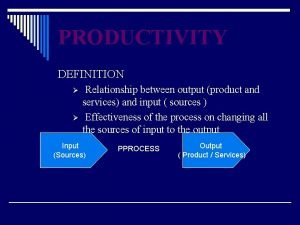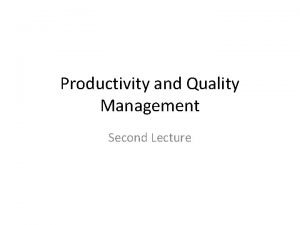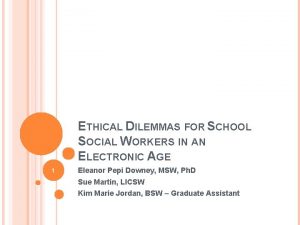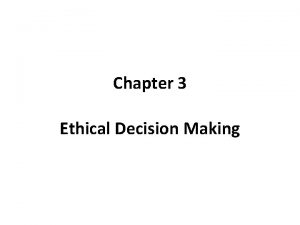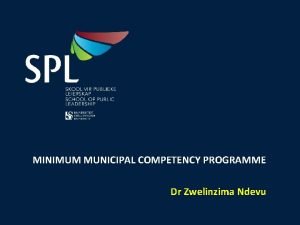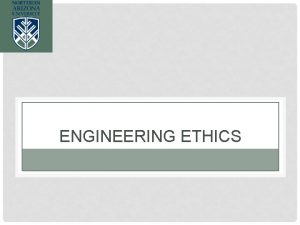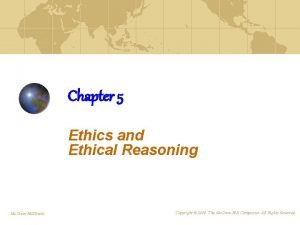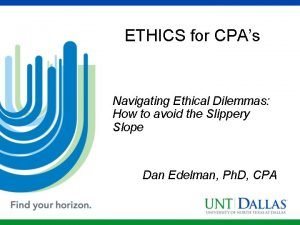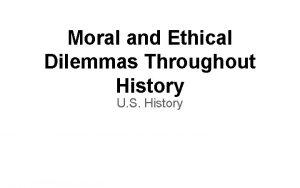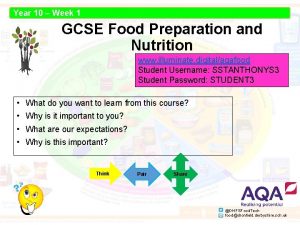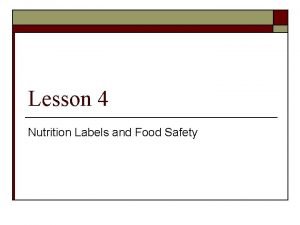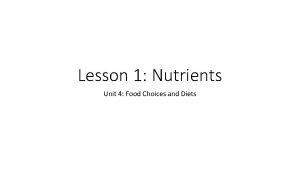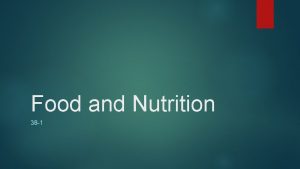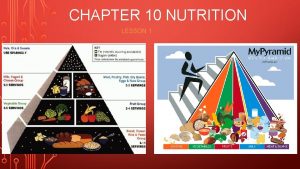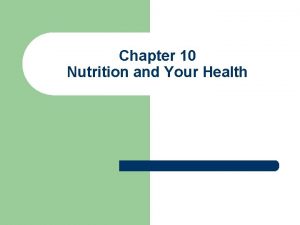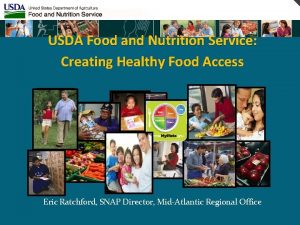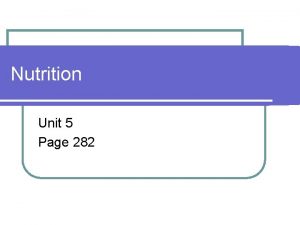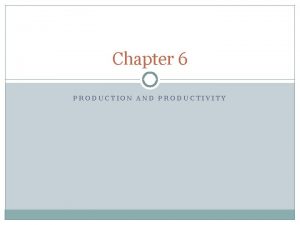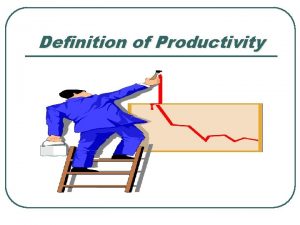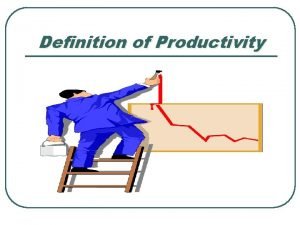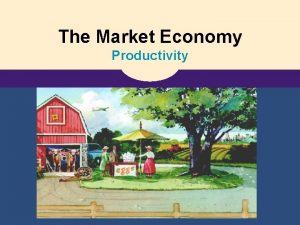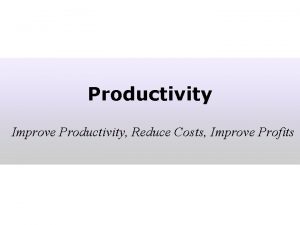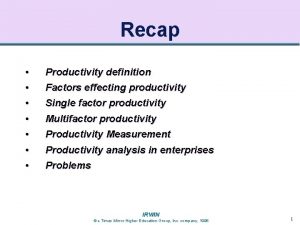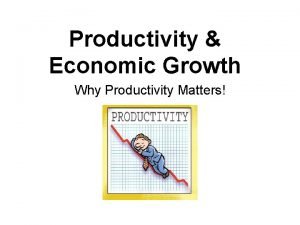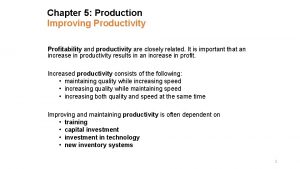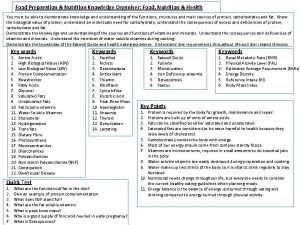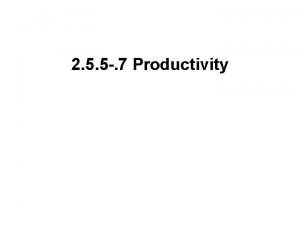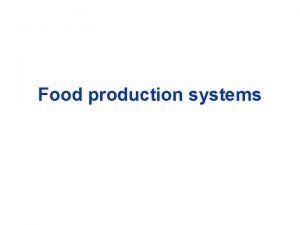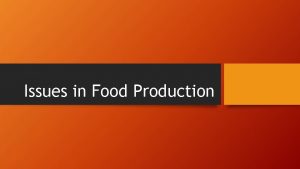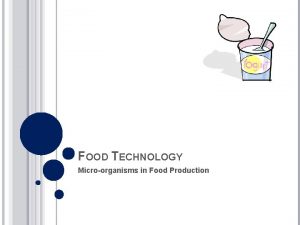THE FOOD PRODUCTION PRODUCTIVITY AND NUTRITION DILEMMAS THE























- Slides: 23

THE FOOD PRODUCTION, PRODUCTIVITY AND NUTRITION DILEMMAS – THE CASE OF GHANA AND THE ROLE OF AGRIBUSINESS By Saa Dittoh Dept. of Climate Change and Food Security, UDS Nyankpala Campus, Tamale Faculty Seminar – 1 st February 2019

Introduction (1/2) ■ Africa has about 60% of uncultivated arable agricultural land, the largest of all the continents yet it is the largest importer of food. ■ Compared to several countries in Africa, Ghana probably has one of the best climatic and agro-ecological conditions for food production. ■ More than half the country can produce two annual crops a year without irrigation. ■ It is also blessed with agro-ecologies that go from mangrove swamps to semi-arid landscapes. ■ That means almost all types of crops and livestock can thrive in Ghana.

Introduction (2/2) ■ The Volta River and its tributaries and several other rivers drain all parts of the country. ■ That means Ghana has considerable surface and ground water resources. ■ Research has shown that Ghana’s surface and ground water resources are quite abundant though actively declining (Obuobi et. al. 2015; Fraiture, 2014). ■ We also have a large proportion of the population in agriculture. ■ Ghana seems to have everything required for the development of the agricultural sector. ■ So what is the problem with Ghana’s agriculture?

Some facts about Ghana’s agriculture ■ Ghana has been generally self-sufficient in the production of cassava, yam, plantain, maize, sorghum, millet, the pulses, several horticultural crops and other crops over time. ■ Maize, which has now become the most dominant crop in Ghana, is reported to have been produced in large quantities and is being exported to neighbouring countries. ■ The main foodstuffs Ghana uses millions of dollars to import are rice, wheat, vegetable oils and meats, but all except wheat can be produced in sufficient quantities even with current consequences of climate change and variability. ■ It is believed that rice imports is a major hindrance to local rice production. (See distributed sheet).

The problem (1/3) ■ So why are we still facing food and nutrition insecurity and so much poverty especially in farming and rural HHs? ■ Some quotations: ■ “There is not much understanding of what is required to develop African peasant (small holder) agriculture” Uma Lele (1981). ■ “We have not fully understood the problems (of African agriculture), we have not identified the priorities, we have not always designed our projects to fit both the agroclimatic conditions of Africa and the social, cultural and political frameworks of Africa … we, and everybody else, are still unclear about what can be done in agriculture in Africa” Ernest Stern (1984), former World Bank Senior Vice President.

The problem (2/3) ■ The problem seems to be that “those that matter” in agricultural policy and/or plan implementation are still yet to understand African Agriculture. ■ A few ideas of people who seem to understand African Agriculture (but whose ideas do not seem to matter): ■ Johnston and Kilby (1975) argued strongly for “progressive modernization of millions of small scale farmers” and stated that the starting point of the development process is “the traditional farmer in a traditional economy”. ■ Benneh (2011) said “Japanese agricultural transformation was based on improvement on their native technology (the Meji technology)” and that “the search for sustainability in agriculture in Africa should begin with the traditional farmer”. ■ ACET (2017) said because of “the uniqueness of the African agricultural context … agricultural transformation in Africa may not be the same or may not follow the same pathways as in other parts of the world”.

The problem (3/3) ■ Hazell (2013) pointed out that “the most obvious way to make agricultural growth pro-poor is to engage with huge numbers of small farms”. He said “small farm development is a win-win proposition because not only are small farmers among the poorest households, they are also the most economically efficient producers”. ■ Dittoh (1981) had earlier argued that “it is only a consistent policy based on evolving a highly productive small-scale farmer as opposed to a green revolution based on large-scale production which can adequately solve the food production problem of the African continent”. ■ Many may say BUT the small farmer had been the focus of our agricultural policy. Let us examine what is being said and what we have been doing!

What we have been doing (1/2) ■ Mo. FA’s vision for Ghana’s agriculture sector is “a modernized agriculture culminating in a structurally transformed economy and evident in food security, employment opportunities and reduced poverty”, (METASIP, 2009). ■ It has not been clear what “modernization” and “transformation” mean to Mo. FA. ■ However statements by “those that matter” and implementation of agricultural policies over time suggest that western agricultural models of large-scale production and the seed-fertilizer green revolution of the Asian continent are the models of “agricultural modernization” being pursued in Ghana and several other African countries; despite the continuous mention of small farmers in policy and plan documents. ■ Basically “technology transfer” models are pursued. (There is, however, hardly any agricultural technology transfer model that has succeeded anywhere in the world)!

What we have been doing (2/2). ■ Priority crops have been maize, rice and soybeans. METASIP I and II, PFJ and major interventions by Development Partners (NRGP, ADVANCE, RESULT, GROW, …. etc) emphasize these crops. ■ They are the crops that fit the “modernization models” but they are not the crops (or systems) derived from “small farmer systems” as advocated by Johnston and Kilby, Benneh, Hazell, Dittoh and others. ■ Priority inputs have been improved seeds, fertilizers, weedicides and insecticides (and almost all are imported). ■ The real issue is a problem of “efficiency-productivity-profitability (E-PP” (SR) versus “sustainability” (LR) of farming systems. ■ It is pursuing “relatively high E-P-P” in the short run versus “relatively low E-P-P” in the long run. ■ Other issues are lack of emphasis on what we regard as food and the food

PFJ Program costing. Source: MOFA (2017) PFJ: Strategic Plan Program Pillars GH¢ Seed 908, 062, 490 27. 23 1, 842, 504, 980 55. 25 Extension Services 277, 741, 800 8. 33 Marketing 277, 741, 800 8. 33 28, 980, 000 0. 87 3, 335, 032, 070 100. 00 Fertilizers E-Agriculture Total %

What we are doing and what we should be doing! LEIA LEISA HEISA LEIA = Low External Input Agriculture (small farmer practices) LEISA = Low External Input and Sustainable Agriculture HEIA = High External Input Agriculture (Western Model) HEISA = High External Input Agriculture

The food and nutrition insecurity problem (1/3)

The food and nutrition insecurity problem (2/3) ■ The main reason why food is produced, i. e. for humans to be well-nourished and be healthy, has been pushed to the background, and production of food to make money has become the focus. THAT IS WHAT WE TEACH!! ■ The risk that arises is irresponsible agribusiness practices, which perpetuate food and nutrition insecurity and consumption of unsafe foods. ■ Several agribusinesses, which are supposed to put VALUE on food along the value chains, tend to be so focused on cutting costs and making money that they invariably destroy the food. ■ Food must be produced to ensure that PEM, MM and OO are avoided or reduced and that the food is safe! ■ Many Ghanaians, however, seem to be unconcerned about MM and OO. ■ “Junk food” seems to be order of the times. ■ Farmers say some high yielding maize varieties are chaff and are meant to be fed to animals; but agriculturists and agripreneurs are much more interested in high yielding varieties.

The food and nutrition insecurity problem (3/3) ■ Roots and tubers (cassava, yam, sweet potato etc), sorghum, millet, local maize varieties as well as the pulses and local vegetables are known to be some the most nutritious foods. They have vitamins (such as vitamin B 17) that can prevent cancers and other diseases, but those are specifically the ones our agriculture sector is not supporting to any degree. ■ While organic foods (even organic toothbrushes – chewing sticks) are the ones the people from where we are copying our technologies are craving for, we are craving for “chemicalized” and junk foods. ■ Even if we become food self-sufficient in maize, rice, soybeans and the crops being promoted now, Ghana (and Africa) will continue to be very food and nutrition insecure until we accept that God did not make a mistake by putting us in a particular environment! We must stop pretending that we are in another environment! ■ According to ACET (2017) millet and sorghum are now seen as nutrientpacked “superfoods” (in India and East Africa).

Synthesis (1/2) ■ Our agriculture, especially food sub-sector, is still in the doldrums. ■ Dzanku and Udry (2017) summarized the prevailing situation as: “farmers in Ghana have been subject to widely fluctuating economic policies over the six post-independence decades… Throughout this period farmers have continued to face the fundamental challenges of inadequate infrastructure, reliance on rain fed cultivation, high transactions costs, highly imperfect financial markets, and a very low level in the public goods of new agricultural technologies, seed systems, cadastral surveys or the legal reforms necessary to make land rights more transparent and secure”. ■ In simple language, for sixty years we have not gone anywhere in the agriculture sector. ■ Question is if the models we have pursued for over six decades are not producing meaningful results why are they still dominant?

Synthesis (2/2) ■ They are still dominant because: ■ 1) They meet the needs of global agribusinesses and their local accomplices; especially the input and equipment suppliers. ■ 2) They have very strong political and elite appeal. ■ 3) They are easy to implement (They meet the needs of lazy project implementers). ■ 4) Researchers are very comfortable with such; they are very simple to deal with. ■ Conclusion is that the Ghanaian (African) agricultural political economy structure is anti-development and must change. ■ The situation is very serious because “dependency on food imports is depressing domestic currencies, driving up inflation, while causing huge UE in rural areas, especially among the youths” (Adesina, 2016).

■ Some misconceptions and contradictions (1/2)farmers do not use “improved planting materials” and fertilizers “Small because they do not know the benefits and because they are illiterate”. The fact is that current high prices of inputs and lack of markets do not make adoption of these practices economically rational or reasonable. Indeed if farmers were to strictly take “farming as a business” we would all have no food to eat! ■ “We must strive to be competitive in the production of rice, soybeans, chickens etc”!! NONSENSE!! Competitive with who? Japan, Thailand, US, Brazil? How can that ever happen? ? Why not concentrate in areas we have competitive advantage? ■ “We need large plantations of tree crops”. Well cocoa has a different story. Our cocoa is desired most because of sun-drying. Imagine sundrying cocoa beans from a 100 hectare farm; not to talk of the slump in price as a result to very large production.

Some misconceptions and contradictions (2/2) ■ “ 5% of farmers feed millions of Americans and that is the correct model to follow”. Many questions arise but let us take just two. What will we do with the 95% displaced farmers? Why has that not happened for over 60 years? ■ “Inorganic fertilizers are the main answer to soil infertility”! Short-run may be; long-run NO! The contribution of pulses to the sustainability of cropping systems, soil fertility and ecosystem resilience as well as human nutrition is enormous (FAO, 2017). CLI is another sustainable soil fertility practice and it has been a small farmer practice. ■ We import improved seeds and fertilizers every year but continue to complain that our farmers use very little of them. So what happens to the large quantities left every year? The massive importation is every year!! ■ Also the farmers do not use these inputs to increase yields yet what they produce have limited markets and low prices. What will happen if they adopt the practices? ■ These misconceptions and contradictions clearly indicate that we do not know what we are doing and do not understand the African smallholder farmer! ■ We are lucky that he/she still feeds us from the < 2 acre hoe and cutlass farm!

What have I done about these ideas? (1/2) ■ Well in the eyes of “those who matter” our ideas “do not matter”!! ■ But I have been convinced of these since my undergraduate times: ■ The Legon Farmer – Rice Production in Northern Ghana (1975). ■ Evolution not Revolution (1981) in Africa Development (CODESRIA). ■ In Nigeria my focus was on irrigated agriculture – IFII model (Dittoh, 1991) (see diagram). Good that FADAMA is big success and there is great support for Farmer-Led Irrigation Development (FLID) world-wide. ■ I fiercely attacked the two main agricultural development systems in Nigeria, WB ADPs and RBDAs, by debunking the “technology transfer” paradigm in Dittoh and Akatugba (1988). ■ In Nigeria was very active in Nigerian Economic Society which has a lot of say in the policies of Nigeria. In Ghana nobody cares about ideas!

What have I done about these ideas? ■ Food and Nutrition Security Unit (FNSU) – Focus was holistic (2/2) understanding of FNS, ended up with Food and Nutrition Security Network! FAO, UNICEF, WFP and many others agree perfectly! UDS scrapped FNSU after my retirement. ■ Still working on Ending Hunger (SDG 2 with WFP and others) ■ Through FNSU and Northern Ghana LEISA Working Group (NGLWG), helped to develop the Plug-In Principle concept (see diagram). Accepted in several parts of the world as innovative but not appreciated much in UDS! ■ Working on FLID with World Bank! ■ Note: I have not said much about METASIP I and II; the plan (which I was a part) and implementation have been two different things!

ILLUSTRATION OF “PLUG-IN” PRINCIPLE Activities of farmers, marketers, processors, caretakers, etc. Plug-in by “bettering” agents (extension health and nutrition agents etc. ) Amalgam of IK and intervention

Role of agribusiness ■ Resolve to undertake responsible agribusiness practices. ■ Lead a campaign for institutionalization of agricultural clusters model – It is a kind of Informal/Formal Agricultural Integration Model where small farmers are treated as equals or even lead partners in the clusters. The clusters work as “business enterprises of all relevant value chain actors”. That means agribusinesses should not be simple buying and selling enterprises. ■ Actively promote the concept of “walking on two legs”. It solves the problem of what comes first – Industry or increased agric production. ■ Agribusinesses are long term phenomena and long term planning (10 to 20 years) is necessary. ■ Agribusinesses must accept that short term profits are windfalls (they come by grace!!) and big risks are normal!!

THANK YOU FOR YOUR ATTENTION AND GOD BLESS YOU!
 Alur proses produksi
Alur proses produksi Healthy food healthy mind journal
Healthy food healthy mind journal Output/product
Output/product Production and productivity definition
Production and productivity definition Jaime baise
Jaime baise School social work ethical dilemmas
School social work ethical dilemmas What is dilemma in ethics
What is dilemma in ethics 5 steps in resolving ethical dilemmas
5 steps in resolving ethical dilemmas Ethical dilemmas in engineering
Ethical dilemmas in engineering What is ethical reasoning
What is ethical reasoning Cpa ethical dilemmas
Cpa ethical dilemmas Ethical dilemmas in history
Ethical dilemmas in history Ethical dilemmas in early childhood education
Ethical dilemmas in early childhood education Leadership dilemmas grid solutions
Leadership dilemmas grid solutions Gcse food tech high skill dishes
Gcse food tech high skill dishes Lesson 4 nutrition labels and food safety
Lesson 4 nutrition labels and food safety Food and nutrition unit 4
Food and nutrition unit 4 Section 38-1 food and nutrition
Section 38-1 food and nutrition Rda food label
Rda food label Section 38-1 food and nutrition
Section 38-1 food and nutrition Chapter 10 lesson 4 nutrition labels and food safety
Chapter 10 lesson 4 nutrition labels and food safety Chapter 10 lesson 4 nutrition labels and food safety
Chapter 10 lesson 4 nutrition labels and food safety Usda food and nutrition service
Usda food and nutrition service Food and nutrition unit 5
Food and nutrition unit 5


